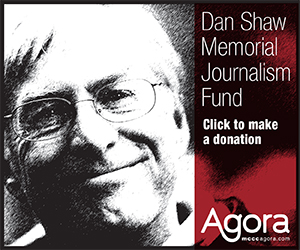After the Roman Empire had fallen and Europe was beginning to awaken, something very different was happening in what is now Temperance, Mich.
The year was around 1200 A.D. and several Native American families had staked their camp in a field not far from the Whitman Center – land that has been occupied for the last 150 years by generations of the Adams family.
Enter Dr. Kenneth Mohney, associate professor of Anthropology at Monroe County Community College, who was invited by the family to investigate the mysterious earlier inhabitants.
“Here is a place where you and I live,” Mohney says. “You are touching a place where they lived and you were the first person to touch it in 800 years. We need to bring these people back to life.”
The Adams’ farmland was transformed into an archaeological site last spring by Mohney and his students. In May, Mohney brought his archaeological fieldwork class to the site, where each student got hands-on experience in the field.
Others who assisted the students on the site included volunteers from Michigan State University, the University of Toledo and the Michigan Archaeological Society. Among them was a pottery expert, who helped identify the period, based on the pottery style.
The site was now a puzzle board, and the pieces of the puzzle were being revealed, one by one, as the team stumbled upon interesting findings.
Evidence of postholes and pits was revealed throughout the excavation. Mohney said the postholes indicated that the early inhabitants built wigwam-type structures.
The wigwams probably were circular, conical dwellings that included a central hearth inside for cooking and warmth, he said.
For the roofing, they may have used cattails or animal skins that were woven into mats.
The pits that were found were not only used to prepare food but also served as wastebaskets, Mohney said. Some of the findings of what they threw away revealed fragments of pottery and stone and charred pieces of animal bone.
Mohney said it’s likely the families gathered in large groups during the summer, then dispersed into smaller ones like the Adam’s site for the fall and winter.
As the team progressed in their excavation, details started to emerge on what the people ate there. Some of the leftovers included traces of burned nutshells and charred animal bone.
“They were so focused on the nut harvest,” Mohney said, adding, “We know they were hunters.”
These hunters may have congregated along the rivers during the summers as the soils there are rich and the wildlife plentiful, Mohney said.
“They may have even lived along the Raisin,” he said.
Mysteries still surround the site, like missing pieces to a puzzle. Mohney explained that, according to Professor Emeritus David Stother’s research at the University of Toledo, the people around the Adams’ site appeared to have been forced from the area, due to pressure from groups in the Sandusky Bay region. The people then relocated to the Saginaw region.
Mohney said that supporting evidence for Stother’s theory can be seen in their pottery, which disappears from the Sandusky area and makes a sudden re-emergence in the Saginaw region.
But the story does not end there. The puzzle pieces can be unearthed if there is more funding for excavations and testing, such as the animal bones that were found.
“We need funding for things like carbon dating,” Mohney said. “We have an idea what some of these species represent, but not exactly as we need someone to analyze the bones.”
Mohney said he hopes a grant can provide the necessary funding. Meanwhile, he anticipates that additional excavations of the site are on the horizon and there is much more beyond the 40 square meters they excavated this spring and summer.
The Adams’ site is significant because it lets us see a part of the archeological record that often escapes notice, Mohney said. Because it is away from major waterways, only a small number of sites of this type have been professionally investigated, he said.
Mohney urged the public to be aware of their surroundings.
“I think it’s important to understand where we came from,” he said.

